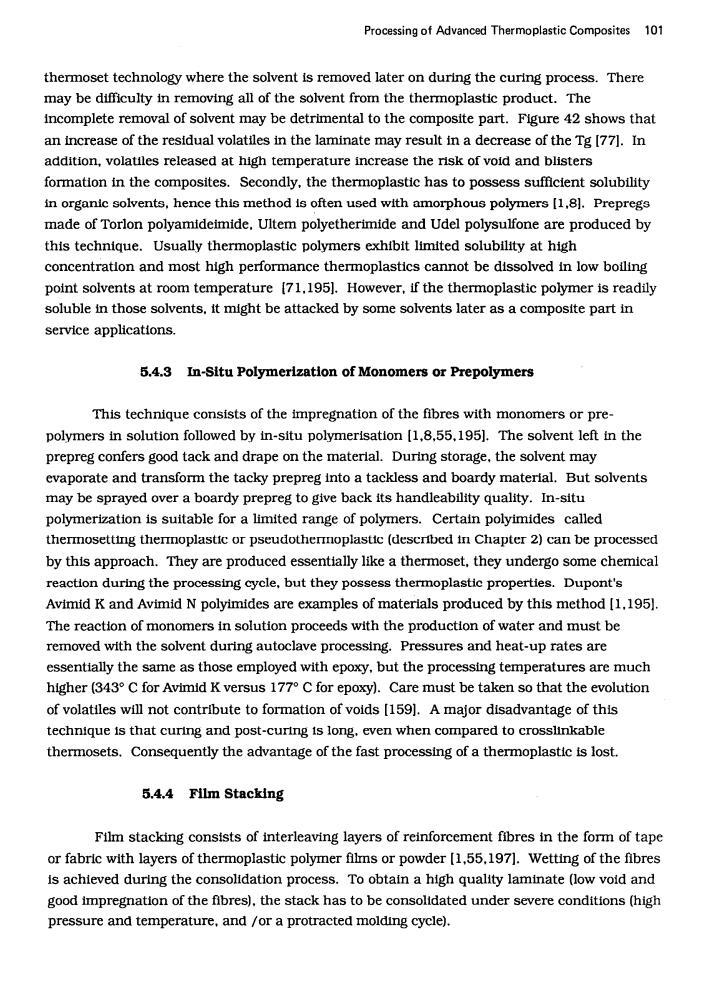正在加载图片...

Processing of Advanced Thermoplastic Composites 101 thermoset technology where the solvent is removed later on during the curing process.There may be difficulty in removing all of the solvent from the thermoplastic product.The incomplete removal of solvent may be detrimental to the composite part.Figure 42 shows that an increase of the residual volatiles in the laminate may result in a decrease of the Tg [77].In addition,volatiles released at high temperature increase the risk of void and blisters formation in the composites.Secondly,the thermoplastic has to possess sufficient solubility in organic solvents,hence this method is often used with amorphous polymers [1.8].Prepregs made of Torlon polyamideimide.Ultem polyetherimide and Udel polysulfone are produced by this technique.Usually thermoplastic polymers exhibit limited solubility at high concentration and most high performance thermoplastics cannot be dissolved in low boiling point solvents at room temperature (71.195].However,if the thermoplastic polymer is readily soluble in those solvents.it might be attacked by some solvents later as a composite part in service applications. 5.4.3 In-Situ Polymerization of Monomers or Prepolymers This technique consists of the impregnation of the fibres with monomers or pre- polymers in solution followed by in-situ polymerisation [1,8,55,195].The solvent left in the prepreg confers good tack and drape on the material.During storage,the solvent may evaporate and transform the tacky prepreg into a tackless and boardy material.But solvents may be sprayed over a boardy prepreg to give back its handleability quality.In-situ polymerization is suitable for a limited range of polymers.Certain polyimides called thermnosetting thermnoplastic or pseudothermoplastic(described in Chapter 2)can be processed by this approach.They are produced essentially like a thermoset,they undergo some chemical reaction during the processing cycle,but they possess thermoplastic properties.Dupont's Avimid K and Avimid N polyimides are examples of materials produced by this method [1,1951. The reaction of monomers in solution proceeds with the production of water and must be removed with the solvent during autoclave processing.Pressures and heat-up rates are essentially the same as those employed with epoxy,but the processing temperatures are much higher(343C for Avimid K versus 177C for epoxy).Care must be taken so that the evolution of volatiles will not contribute to formation of voids [159].A major disadvantage of this technique is that curing and post-curing is long,even when compared to crosslinkable thermosets.Consequently the advantage of the fast processing of a thermoplastic is lost. 5.4.4 Film Stacking Film stacking consists of interleaving layers of reinforcement fibres in the form of tape or fabric with layers of thermoplastic polymer flms or powder [1,55.197].Wetting of the fibres is achieved during the consolidation process.To obtain a high quality laminate (low vold and good impregnation of the fibres).the stack has to be consolldated under severe conditions(high pressure and temperature,and /or a protracted molding cycle).Processing of Advanced Thermoplastic Composites 101 thermoset technology where the solvent is removed later on during the curing process. There may be difficulty in removing all of the solvent from the thermoplastic product. The incomplete removal of solvent may be detrimental to the composite part. Figure 42 shows that an increase of the residual volatiles in the laminate may result in a decrease of the Tg 1771. In addition, volatiles released at high temperature increase the risk of void and blisters formation in the composites. Secondly, the thermoplastic has to possess sufficient solubility in organic solvents, hence this method is often used with amorphous polymers [ 1.81. Prepregs made of Torlon polyamideimide. Ultem polyetherimide and Udel polysulfone are produced by this technique. Usually thermoplastic polymers exhibit limited solubility at high concentration and most high performance thermoplastics cannot be dissolved in low boiling point solvents at room temperature (7 1.1951. However, if the thermoplastic polymer is readily soluble in those solvents, it might be attacked by some solvents later as a composite part in service applications. 5.43 In-Situ Polymerization of Monomers or Prepolymers This technique consists of the impregnation of the fibres with monomers or prepolymers in solution followed by in-situ polymerisation [1,8,55,195]. The solvent left in the prepreg confers good tack and drape on the material. During storage, the solvent may evaporate and transform the tacky prepreg into a tackless and boardy material. But solvents may be sprayed over a boardy prepreg to give back its handleability quality. In-situ polymerization is suitable for a limited range of polymers. Certain polyimides called thermosetting thermoplastic or pseudothermoplastic (described in Chapter 2) can be processed by this approach. They are produced essentially like a thermoset. they undergo some chemical reaction during the processing cycle, but they possess thermoplastic properties. Dupont’s Avimid K and Avimid N polyimides are examples of materials produced by this method [1.195]. The reaction of monomers in solution proceeds with the production of water and must be removed with the solvent during autoclave processing. Pressures and heat-up rates are essentially the same as those employed with epoxy, but the processing temperatures are much higher (343’ C for Avimid K versus 177” C for epoxy). Care must be taken so that the evolution of volatiles will not contribute to formation of voids [ 1591. A major disadvantage of this technique is that curing and post-curing is long, even when compared to crosslinkable thermosets. Consequently the advantage of the fast processing of a thermoplastic is lost. 5.4.4 Film Stacking Film stacking consists of interleaving layers of reinforcement fibres in the form of tape or fabric with layers of thermoplastic polymer films or powder ]1,55.197]. Wetting of the fibres is achieved during the consolidation process. To obtain a high quality laminate (low void and good impregnation of the fibres), the stack has to be consolidated under severe conditions (high pressure and temperature, and /or a protracted molding cycle)